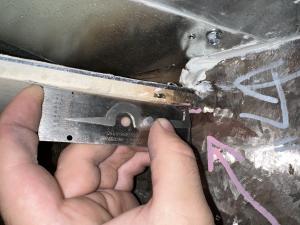How Welding Inspection Racine Makes Certain Security and Conformity
How Welding Inspection Racine Makes Certain Security and Conformity
Blog Article
Innovative Techniques to Fillet Weld Assessment and Screening: Enhancing Weld Quality and Compliance Standards
In the world of welding, the quality and integrity of fillet welds play a critical role in ensuring the architectural sturdiness and reliability of numerous commercial parts. With the consistent drive for improved efficiency and conformity with stringent requirements, the exploration of innovative methods to fillet weld examination and screening has actually ended up being essential.
Advanced Non-Destructive Testing Techniques
Utilizing state-of-the-art innovations, progressed non-destructive screening methods play a crucial role in making sure the honesty and high quality of fillet welds. These techniques, such as phased selection ultrasonic screening (PAUT) and magnetic fragment screening (MPT), offer in-depth understandings into the weld's interior structure without triggering any kind of damages to the material. PAUT, for example, utilizes several ultrasonic aspects to inspect the weld from various angles, providing a detailed visualization of possible problems like lack of fusion or fractures.
By using these innovative non-destructive screening techniques, weld assessors can accurately analyze the quality of fillet welds, ensuring conformity with market standards and policies. The ability to discover defects early on not only improves weld quality but also prevents costly rework or failings in structural honesty, underlining the significance of these ingenious testing techniques in welding inspections.
Robotics and Automation in Examination
The assimilation of robotics and automation has reinvented the assessment procedure for fillet welds, improving effectiveness and accuracy in top quality analysis. Robotics use accurate control and repeatability in checking welds, ensuring trusted and consistent results. Automated systems can be set to follow specific examination courses, ensuring complete insurance coverage of welds and reducing the danger of human error.
Robotic assessment systems outfitted with innovative sensing units can discover and gauge weld attributes with high precision, offering in-depth information for analysis. These systems can identify flaws such as fractures, lack of fusion, and porosity, enabling punctual corrective activities to be taken. In addition, robotics and automation enable real-time data collection and analysis, providing instant comments to operators and facilitating fast decision-making procedures.
Additionally, using robotics and automation in fillet weld examination improves general efficiency by minimizing assessment times and enhancing inspection throughput. By streamlining the evaluation procedure, makers can guarantee weld quality and compliance criteria are satisfied effectively, eventually bring about cost financial savings and boosted item top quality.
Using Expert System for Analysis
Synthetic knowledge plays a critical function in boosting the performance and accuracy of evaluation in fillet weld inspection procedures. By using the power of AI, assessors can enhance the evaluation of weld quality and compliance requirements, bring about extra accurate and reputable results. AI algorithms can quickly refine substantial quantities of information from weld evaluations, finding flaws or inconsistencies that may be testing to understand the nude eye. This innovative technology enables real-time surveillance of weld high quality, allowing for instant restorative actions to be taken if any kind of concerns are discovered.
Moreover, AI systems can gain from previous assessment information, continually enhancing their capacity to determine prospective problems and variances in fillet welds. This adaptive discovering ability improves the total top quality control procedure, decreasing the possibility of human error and making sure that welds satisfy the needed criteria. By incorporating expert system into fillet weld analysis, markets can attain greater levels of effectiveness, uniformity, and compliance in their inspection practices.
Portable Devices for On-Site Evaluation
 Enhancing field assessment performance, the fostering of portable tools reinvents on-site evaluation procedures for fillet welds. These devices offer flexibility and ease, permitting examiners to carry out extensive evaluations in numerous places, including tough or remote atmospheres. Mobile devices such as ultrasonic other testing tools, magnetic bit assessment devices, and digital radiography systems give real-time information and high-resolution imaging abilities, allowing fast decision-making and prompt comments on weld quality.
Enhancing field assessment performance, the fostering of portable tools reinvents on-site evaluation procedures for fillet welds. These devices offer flexibility and ease, permitting examiners to carry out extensive evaluations in numerous places, including tough or remote atmospheres. Mobile devices such as ultrasonic other testing tools, magnetic bit assessment devices, and digital radiography systems give real-time information and high-resolution imaging abilities, allowing fast decision-making and prompt comments on weld quality.One considerable benefit of mobile tools is their ability to simplify examination procedures, lowering downtime and improving general productivity. Inspectors can easily transfer these tools to various task sites, removing the requirement for delivering heavy machinery or elements to off-site centers. Furthermore, the transportability of these devices promotes cost-effectiveness by decreasing transportation expenditures and accelerating assessment timelines.
Additionally, the use of mobile devices for on-site evaluation advertises proactive high quality control actions, as inspectors can promptly identify and attend to any prospective welding flaws or disparities. By integrating these ingenious modern technologies into on-site inspection techniques, welding specialists can ensure conformity with sector standards and enhance weld top quality, ultimately bring about enhanced architectural honesty and security in various welding applications.
Combination of Information Administration Systems
Having optimized on-site examination procedures through the utilization of portable tools, the following phase includes the seamless assimilation of information administration systems to even more boost efficiency and data analysis abilities in fillet weld examination and testing. Welding Inspection Racine. By incorporating information administration systems into the inspection process, organizations can simplify information collection, storage, and evaluation. This integration enables real-time surveillance of weld high quality, prompt identification of flaws, and prompt decision-making to remedy any kind of problems that may occur during the assessment process
Information management systems play a vital role in systematizing inspection data, assisting in very easy accessibility for authorized workers, and ensuring data stability and protection. With the assimilation of these systems, assessors can create extensive reports, track historical information for trend evaluation, and enhance overall process effectiveness. Additionally, the assimilation of information management systems allows smooth interaction between different stakeholders associated with the assessment process, cultivating collaboration and enhancing total quality assurance steps. Eventually, the combination of information administration systems serves to elevate the standards of fillet weld inspection and testing, ensuring compliance with market guidelines and enhancing weld high quality.
Final Thought
In conclusion, innovative techniques to fillet weld inspection and screening have significantly enhanced weld high quality and compliance requirements. Advanced non-destructive testing techniques, robotics, automation, fabricated knowledge, mobile tools, and information monitoring systems have actually changed the method weld go to this website inspections are carried out. By using these modern technologies, industries can make certain that welds meet the required high quality standards and laws, ultimately improving overall efficiency and security in welding procedures.

By utilizing these sophisticated non-destructive testing strategies, weld examiners can properly assess the quality of fillet welds, making certain compliance with sector requirements and policies. Mobile tools such as ultrasonic screening gadgets, magnetic fragment inspection equipment, and electronic radiography systems offer real-time data and high-resolution imaging abilities, enabling quick decision-making and immediate responses on weld high quality.
Having actually optimized on-site examination procedures via the utilization of mobile tools, the next stage includes the smooth combination of data management discover here systems to further enhance performance and data analysis abilities in fillet weld assessment and testing (Welding Inspection Racine). Inevitably, the integration of information monitoring systems offers to elevate the requirements of fillet weld assessment and testing, making certain compliance with industry policies and improving weld quality
 In verdict, innovative techniques to fillet weld inspection and testing have actually considerably improved weld high quality and compliance requirements.
In verdict, innovative techniques to fillet weld inspection and testing have actually considerably improved weld high quality and compliance requirements.Report this page